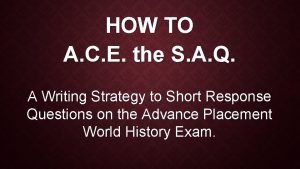ACE the SAQ HOW TO ACE THE SAQ






- Slides: 6

ACE the SAQ

HOW TO ACE THE SAQ • ACE it • A - Answer • C – Cite Examples • E – Expand • A = Answer. You directly answer the question by identifying your claim using Specific Factual Information (SFI). • C = Cite. You briefly define/describe/support your claim by using additional Specific Factual Information (SFI). • E = Expand. You connect your claim through historical context.

HISTORICAL THINKING SKILL: CONTEXTUALIZATION • Students should be able to: • C 3—Situate historical events, developments, or processes within the broader regional, national, or global context in which they occurred in order to draw conclusions about their relative significance. • Local context • Broader context • Other context (synthesis)

EXAMPLE • Prompt (i. e. Part A): Briefly explain ONE important political development of the sectional conflict over slavery during the 1850’s. • ANSWER: The Kansas Nebraska Act in 1854 was another attempt to settle the sectional conflict over slavery during the 1850’s. • CITE: The act split the Nebraska Territory into two new territories, Nebraska and Kansas, and allowed each territory to determine free state or slave state through popular sovereignty. • EXPAND: Although the Kansas Nebraska Act attempted to settle the conflict over slavery through a more democratic means, it consequently allowed slavery to expand beyond the Missouri Compromise line of 36’ 30 and was considered a political victory for “slave power. ”

SAQ-2018 • AP Exam: Section 1, Part B: 3 questions, 40 Minutes, 20% of Exam Score • Students respond to two required questions and choose between two options for a third question. • Questions 1 and 2 cover periods 3– 8 of the course; students choose between answering either question 3 (periods 1– 5) or question 4 (periods 6– 9). • Students analyze historians’ interpretations, historical sources, and propositions about history. • Questions provide opportunities for students to explain the historical examples that they know best. • No thesis statement required (Just ACE) • Each part of the prompt answered is worth one point. • No partial points awarded

2016 SAQ a. Briefly explain ONE important similarity between the goals of the Spanish and the English in establishing colonies prior to 1700. b. Briefly explain ONE important difference between the goals of the Spanish and the English in establishing colonies. c. Briefly explain ONE way in which the differences indicated in (b) contributed to a difference in the development of Spanish and English colonial societies.








